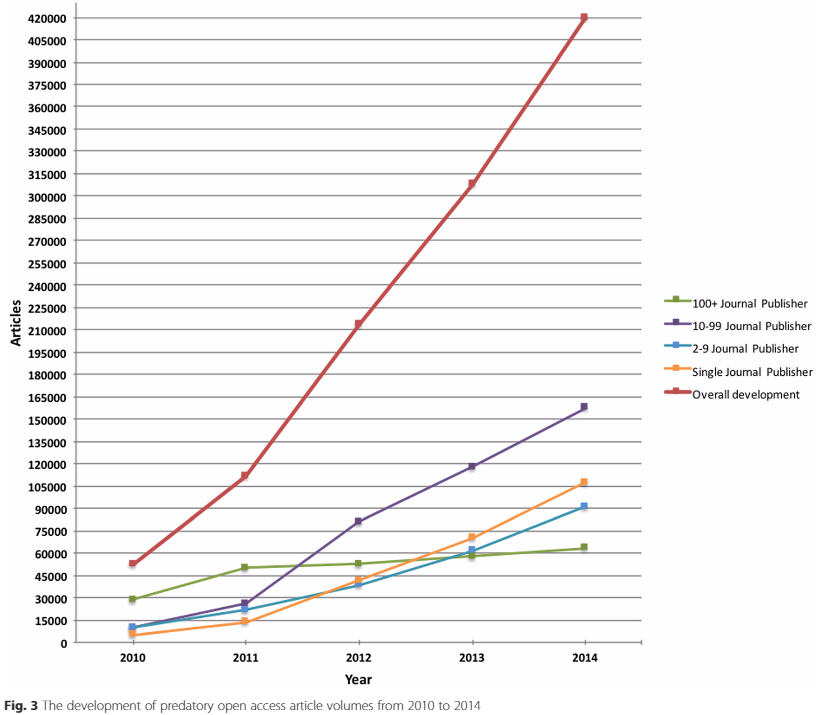You have /5 articles left.
Sign up for a free account or log in.
The rise of open-access publishing, combined with pressure on academics to get published, has caused a spectacular increase in the number of articles spewed out by “predatory” journals, according to researchers at Finland’s Hanken School of Economics.
Such journals, of which there are thousands, charge authors hundreds of dollars in return for lackluster or nonexistent peer review and rapid publication. According to Cenyu Shen and Bo-Christer Bjork, the co-authors of “‘Predatory’ Open Access: A Longitudinal Study of Article Volumes and Market Characteristics,” the journals dumped more than 420,000 articles into the market in 2014, up from 53,000 in 2010.
The report appears in the open-access journal BMC Medicine. The authors used Jeffrey Beall's lists of predatory publishers and journals as a starting point for the study. Beall, scholarly communications librarian and associate professor at the University of Colorado at Denver, has developed 52 criteria to determine inclusion on the lists, with criteria ranging from whether a publisher solicits submissions via spam messages to the makeup (or existence) of a journal’s editorial board.
The lists, which are regularly updated, contain hundreds of publishers and journals. Shen and Bjork did their study based on a sample of 613 journals, and write that their results should be treated as a “rough estimate.”
Heather Joseph, executive director of the Scholarly Publishing and Academic Resources Coalition (SPARC), called the increase from 2010 to 2014 “stunning.”
The “findings underscore that some longstanding cultural norms and practices in research evaluation are inconsistent with encouraging high-quality outputs -- and that results of these practices can manifest themselves in unexpectedly pernicious and damaging ways,” Joseph, whose organization promotes open forms of scholarly communication, said in an email.
Predatory publishers and journals are a byproduct of the open-access movement. In order to provide free access to readers, many journals have passed costs on to authors themselves, charging them an article-processing fee that can range from a few hundred to several thousand dollars. As that model of funding the dissemination of research -- also known as gold open access -- has grown more popular, it has also opened itself up to abuse.
Authors from Africa and Asia appear most willing to take the risk. They make up 76.7 percent of the authors of the articles captured in the study. Authors from India alone make up more than one-third, or 34.7 percent.
“The pressures that current academic evaluation practices place on researchers are a contributing factor to the rise of these predatory journals,” Joseph wrote. “The practice of judging authors on where an article is published rather than on the quality of the information in the article itself is clearly one that needs to be challenged. And while this study illustrates what happens when this practice is systematized on a national level, the reality is that it is a persistent problem in academic institutions around the world, and needs to be addressed.”
India’s and China’s populations obviously skew the geographic breakdown. When it comes to the number of articles per capita, another country comes out on top: Nigeria. The researchers calculated each country’s ratio of articles published in predatory journals to those indexed in Thomson Reuters’s Web of Science. Nigeria had the highest ratio -- 1,580 percent -- followed by India (277 percent), Iran (70 percent) and the U.S. (7 percent).
Requirements on academics in those countries to get published in Western journals is only making the issue worse, the authors argue. And indeed, many of the journals on Beall’s list include words such as “Global,” “International,” “World” or references to continents and regions in their titles.
Beall’s work is not without controversy, however. Some researchers have accused him of “actively trying to discredit open-access publishing in general,” while others have criticized his inclusion of certain publishers as baseless and “irresponsible.”
In an email, Beall said the report attempts to “minimize” the impact of predatory publishing by focusing on Africa and Asia.
“Because research is cumulative, the entire research system is threatened when un-peer-reviewed science is published and circulated,” Beall wrote. “Just because predatory publishers are not a problem in Finland does not mean they are not a serious problem for scientists, scientific communication and science itself.”
Beall said he detected a “strong undertone of open-access triumphalism” in the report. Based on his own work, he said the number of predatory journals has likely continued to grow since 2014.
“The increase is significant and shows that predatory journals are saturating scholarly communication,” Beall wrote. “Too many open-access advocates think that because OA is not a problem for them personally, they're not a problem at all. This is absolutely not true. Research published in predatory journals is polluting the entire scholarly publishing ecosystem.”





